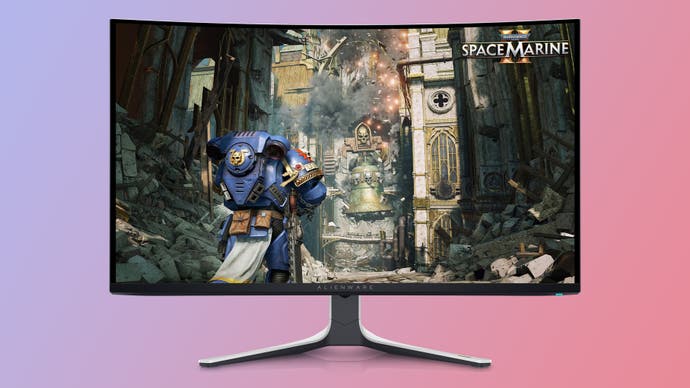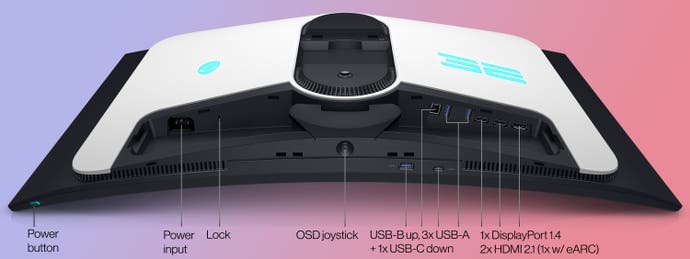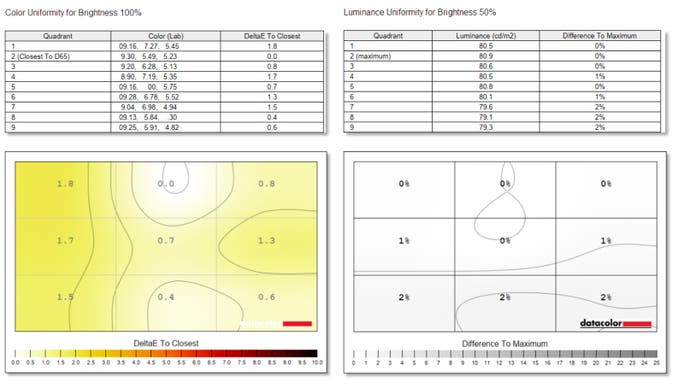Dell Alienware AW3225QF review: the best 32-inch QD-OLED for UK buyers
This 4K 240Hz screen has impressive Dolby Vision HDR too.
Earlier this month I reviewed the Asus ROG Swift PG32UCDM, a 32-inch QD-OLED gaming monitor that combines a 4K resolution with 240Hz refresh rate, impressive HDR and fewer downsides than your typical OLED panel - albeit at an eye-watering £1350 asking price. I noted that while the Asus monitor was a technical tour de force and the best gaming monitor I'd ever tested, it's not necessarily the best value 32-inch QD-OLED. For that, UK buyers ought to be looking at the subject of this review: Dell's £940 Alienware AW3225QF, which uses the exact same QD-OLED panel and therefore ought to offer nigh-identical performance - for £410 less.
Despite that massive price delta, the Alienware is far from a compromised budget alternative - it packs many of the same features as the Asus model and even adds on Dolby Vision support and a curved form factor that suit its expansive proportions.
In this AW3225QF review, I'll cover how the monitor compares to the more expensive Asus model, how meaningful Dolby Vision support is as a value-add and whether the curved screen adds or detracts from the experience - as well as a summary of the 32-inch QD-OLED panel's characteristics for gaming, video and work, given that we've already covered the panel in some detail in the Asus ROG Swift PG32UCDM review two weeks ago.
Unlike many other display types, OLED panels can curve - so after being produced by Samsung Display, vendors like Dell, Asus and MSI are free to choose flat, curved or even flexible configurations (eg the 45-inch Corsair Xeneon Flex). Dell opted for a curved design, unlike MSI and Asus, and so this is the first point of differentiation you're likely to notice - and care about - when considering each of these designs.
I've used a fair few curved monitors in the past, but I generally prefer flat panels as I do a fair amount of work in text editors, spreadsheets and other productivity applications where it's nice for straight lines to appear straight. The good news is that the Alienware's 1700R curvature is actually quite mild for a monitor of this size, with each corner perhaps only a few centimetres further forward than it would be on a completely flat monitor. That makes the AW3225QF an easy monitor to get used to, appearing slightly more immersive in gameplay without making your spreadsheets look noticeably odd. This feels like the right choice for Dell, who get a nice point of differentiation against their rivals without making it a deal-breaker for those that prefer flat screens.

Beyond the curve, the AW3225QF follows the same design principles as Dell's other new QD-OLED (the 1440p 360Hz AW2725DF, review coming soon) with a subtly printed white Alienware wordmark across the slightly chunky bottom bezel, a four-way joystick just beneath and a power button with LED indicator way on the right side of the monitor. (After using a lot of monitors with centrally-located power buttons, I admit to a few minutes of panic when prodding the joystick didn't turn it on and I hadn't yet spotted the separate power button.)
The back of the monitor comes in Alienware white plastic, and by default has a teal-backlit alien head on one side and teal-backlit '32' text on the other - just in case you forget what monitor size you picked. The stand is elegant and capable, with height, tilt and swivel adjustment and more of that space-y white/black plastic finish, but unless you're really trying to match a white PC build I'd recommend using a 100x100 VESA monitor arm to clear out some much-needed mousing space on your desk. Thankfully, at six kilos the monitor isn't hard to mount.
Underneath, you get a DisplayPort 1.4 port (for 4K 240Hz with DSC) and two HDMI 2.1 ports (4K 240Hz, though limited to 4K 120Hz on PS5/Series X). Interestingly, the first HDMI port supports eARC to send high-res multi-channel audio to sound systems, one of the few monitors I've seen to include this functionality - and a clever inclusion for a monitor that also supports Dolby Vision. However, there's no 3.5mm headphone jack or built-in speakers, either of which could have been nice for console use.

While MSI and Asus 32-inch QD-OLEDs include a USB-C video and data port with up to 90W USB PD and KVM switch functionality, the Dell only includes a simple USB-B downstream port that connects a four-port USB hub (one USB-C, three USB-A, all 5Gbps). That means you don't have an option to connect a modern laptop with audio, video, data and power over a single cable, which is a bit of a shame and perhaps the first true evidence of cost savings on the Alienware versus its rivals.
The OSD here is also a little more feature-poor than Asus and MSI's menus, with only two anti burn-in controls - to prompt a pixel refresh or full panel refresh - and toggles or adjustments available for features like taskbar and logo detection. To be clear, these features still appear to be enabled, but there's no user control of them which seems a bit of a shame. As with the other models using this 32-inch QD-OLED panel, a three-year warranty that covers burn-in is included with the AW3225QF.
Let's move now to the Alienware's other unique feature: Dolby Vision. This is something of a let-down in Windows 11, as while Windows recognises the monitor as having Dolby Vision support, I wasn't able to actually play any local Dolby Vision video files and only a handful of games with Dolby Vision enabled. Streaming Dolby Vision titles in Netflix did work, at least. The list of officially supported titles only includes a handful older Frostbite engine games like Need for Speed Heat and Mass Effect Andromeda, and they didn't quite work as intended, with Andromeda requiring 4K 60Hz output to work correctly. Thankfully, a firmware update does at least allow Dolby Vision mode to be disabled in the monitor's OSD, so you don't have to deal with Dolby Vision being used when HDR is enabled - with too-bright results.
On Xbox it's not too much better in terms of mainstream game support, but does at least include the likes of Borderlands 3, Forza Horizon 5 and Metro Exodus, and every game I tried worked perfectly without any hassle. Of course, you can also stream Dolby Vision video on the Xbox - and other HDMI devices like the Nvidia Shield - so Dolby Vision support is still quite a useful addition on that front.
Thankfully, regular HDR content still looks fantastic on PC and other platforms, so while the Alienware doesn't meaningfully gain anything against its rivals for PC use, watching HDR films and playing HDR games is still demonstrably better than the vast majority of LCD-based alternatives on the market - so that's something.
Going into more objective testing now, the AW3225QF hits the same highs as the Asus PG32UCDM, with full coverage of sRGB in its Creator mode, 99 percent DCI P3 coverage and 97 percent Adobe RGB coverage. Colour accuracy in sRGB was incredible, with an average Delta-E score of 1.0 that suggests inaccuracies invisible to the naked eye, and HDR highlights are also impressively bright at up to 1000 nits. Finally, pixel response times are incredibly quick at around 0.3ms, but there's no black frame insertion feature as we saw on the Asus model. I tended to keep that mode disabled anyway, but it would have been nice to this as an option.

As with other QD-OLED monitors we've tested, bright environments can cause black pixels to look slightly purple or grey, but in dark or moderate lighting conditions they look properly black as you'd hope - so W-OLED or an LCD-based monitor might be a better choice if you're forced to use the monitor in rather harsh lighting conditions. The glossy screen coating here is also effective at handling reflections.
I didn't face any issues with SDR brightness, which at 250 nits was more than sufficient for my use case, even with largely white content like web pages maximised on the screen. This 32-inch 4K monitor defaults to 150 percent scaling in Windows, but 125 percent or even 100 percent scaling are fine alternatives if you have good eyesight and want more screen real estate.
As you'd expect from the specs on offer here, performance is great in a wide range of PC games. You have the luxury of the crisp details and gorgeous colour reproduction of a 4K OLED screen with an esports-grade 240Hz refresh rate and near instant pixel response times, so a wide range of gaming genres are represented at their best. As I mentioned with the Asus monitor, the physically larger size was surprisingly good in competitive shooters like Counter-Strike 2 and Call of Duty Warzone, where the larger pixels made distant enemies a little easier to spot.

On Xbox Series X or PS5, you're unlikely to even be hitting 4K 120Hz in many games, but with full HDMI 2.1 bandwidth available, you're at least taking full advantage of what the platforms have to offer. And who knows, maybe you'll be fully ready for the PlayStation 6 or Xbox Series XXX!
Outside of gaming, the third-generation Samsung Display QD-OLED panel used here has an improved subpixel arrangement that results in sharper text without the obvious colour fringing that were noticeable in older QD-OLED monitors, making this a much better choice for web browsing, programming, content creation and so on. As always, OLED isn't ideally matched for these use cases given that they're more likely to cause burn-in than gaming or video content, but with that three-year warranty and countermeasures in place, I don't have any particular hangups about using this monitor for work when needed. I'll report back if I do notice any burn-in during long-term testing.
All things considered then, the Dell Alienware AW3225QF is an easy recommendation for UK buyers, where its significantly lower price than competing 32-inch QD-OLED models from Asus and MSI make it the obvious choice. Elsewhere in the world, the Dell is still a unique proposition well worth considering - especially if you want to play Dolby Vision content via an Xbox or other HDMI media player, or particularly like curved screens rather than flat ones. However, the disappointing Dolby Vision handling in Windows 11, some missing OSD options, no BFI and the lack of a USB-C input are minor blemishes on an otherwise excellent monitor.









